- Home
- L. Ron Hubbard
Devil's Manhunt Page 8
Devil's Manhunt Read online
Page 8
“Well—just as a favor to you, I’ll let you do it. I’ll even pay you a couple hundred for the job.”
“That’s white!” cried Brazos in relief. “I knew you’d help me.”
Whisper had won and he threw off his lethargy. “Henry, you saddle up Beans and ride hell for leather for the buttes. About dark you cut back, take to the bed of Dead River to cover your trail and come home.”
About an hour later Brazos was lying in the mow, not daring to breathe while Whisper “discovered” with shocked alarm that he had aided the escape of a criminal. But shortly Brazos breathed again, for the posse, hot for blood, went thundering out of town on the trail of Beans and Henry, flailing their jaded mounts and licking their chops as they envisioned the riddled corpse of one Brazos.
Whisper stood in the door watching them become a cloud of dust. Whisper, down inside, was laughing, but not at the joke he had played on the posse.
To find out more about Shadows from Boot Hill and how you can obtain your copy, go to www.goldenagestories.com.
Glossary
STORIES FROM THE GOLDEN AGE reflect the words and expressions used in the 1930s and 1940s, adding unique flavor and authenticity to the tales. While a character’s speech may often reflect regional origins, it also can convey attitudes common in the day. So that readers can better grasp such cultural and historical terms, uncommon words or expressions of the era, the following glossary has been provided.
alkali: a powdery white mineral that salts the ground in many low places in the West. It whitens the ground where water has risen to the surface and gone back down. → to text
bead on, take a: to take careful aim at. This term alludes to the bead, a small metal knob on a firearm used as a front sight. → to text
blamed: confounded. → to text
blue chip: a poker chip having a high value. → to text
boot: saddle boot; a close-fitting covering or case for a gun or other weapon that straps to a saddle. → to text
buffalo gun: .50-caliber Sharps rifle, also called the “Big Fifty,” which weighed twelve pounds. Noted for its power and range, it was the almost unanimous choice among buffalo hunters. The drawbacks were the cost of ammunition and the fact that the rifle’s accuracy was seriously affected by rapid fire (it had to be watered down constantly to keep from overheating). → to text
calabozo: (Spanish) jail. → to text
Colt: a single-action, six-shot cylinder revolver, most commonly available in .45- or .44-caliber versions. It was first manufactured in 1873 for the Army by the Colt Firearms Company, the armory founded by American inventor Samuel Colt (1814–1862) who revolutionized the firearms industry with the invention of the revolver. The Colt, also known as the Peacemaker, was also made available to civilians. As a reliable, inexpensive and popular handgun among cowboys, it became known as the “cowboy’s gun” and a symbol of the Old West. → to text
cowpuncher: a hired hand who tends cattle and performs other duties on horseback. → to text
Derringer: a pocket-sized, short-barreled, large-caliber pistol. Named for the US gunsmith Henry Deringer (1786–1868), who designed it. → to text
drag: the rear of a column of cattle on the trail. It includes the footsore, the weak, the young calves, the weary and the lazy. The drag position is no fun for the hands assigned to ride it—they have to make the sick and the stragglers keep up, chase the breakaways and suffer the dust. Since it is unpleasant, green hands usually get assigned to ride drag. → to text
fan: to fire a series of shots (from a single-action revolver) by holding the trigger back and successively striking the hammer to the rear with the free hand. → to text
Giant: Giant powder; dynamite manufactured by the Giant Powder Co, the first US dynamite manufacturing plant, in 1870 in San Francisco, California. “Giant powder” was a long time synonym for dynamite in the US. → to text
gig: a light carriage, with one pair of wheels, drawn by one horse. → to text
G-men: government men; agents of the Federal Bureau of Investigation. → to text
gumbo: soil that turns very sticky and muddy when it becomes wet; found throughout the central US. → to text
half-breed: a person with parents of different races, usually a white father and Native American mother. The term originated in the East, not the Western frontier. → to text
hoss: horse. → to text
hostler: a person who takes care of horses, especially at an inn. → to text
jenny: a female donkey. → to text
jimminies, by: a mild exclamation of surprise, emotion or awe. → to text
larrup: to beat, flog or thrash, said of a horse to make it go faster. → to text
livery stable: a stable that accommodates and looks after horses for their owners. → to text
Martini-Henry: a breech-loaded .45-caliber rifle adopted in 1871 as the standard British service weapon, named after its inventors. → to text
Mickey Finn: a drug-laced drink given to someone without their knowledge in order to incapacitate them. Named after a bartender who, before his days as a saloon proprietor, was known as a pickpocket and thief who often preyed on drunken bar patrons. → to text
mow: haymow; the upper floor of a barn or stable used for storing hay. → to text
owl-hoot: outlaw. → to text
parley: to talk or negotiate, especially with an enemy. → to text
Peacemaker: nickname for the single-action (that is, cocked by hand for each shot), six-shot Army model revolver first produced in 1873 by the Colt Firearms Company, the armory founded by Samuel Colt (1814–1862). The handgun of the Old West, it became the instrument of both lawmaker and lawbreaker during the last twenty-five years of the nineteenth century. It soon earned various names, such as “hog leg,” “Equalizer,” and “Judge Colt and his jury of six.” → to text
placer: a waterborne deposit of gravel or sand containing heavy ore minerals, as gold, which have been eroded from their original bedrock and concentrated as small particles that can be washed out. → to text
poke: a small sack or bag, usually a crude leather pouch, in which a miner carried his gold dust and nuggets. → to text
Prop.: Proprietor. → to text
puncher: a hired hand who tends cattle and performs other duties on horseback. → to text
quirt: a riding whip with a short handle and a braided leather lash. → to text
rannies: ranahans; cowboys or top ranch hands. → to text
riffles: in mining, the strips of metal or wooden slats fixed to the bottom of a rocker box or sluice (a long sloping trough into which water is directed), that run perpendicular to the flow of water. The weight of the gold causes it to sink, where it is captured by these riffles. → to text
Scheherazade: the female narrator of The Arabian Nights, who during one thousand and one adventurous nights saved her life by entertaining her husband, the king, with stories. → to text
sidewinder: rattlesnake. → to text
sinks: depressions in the land surface where water has no outlet and simply stands. The word is usually applied to dry lake beds, where the evaporating water has left alkali and other mineral salts. → to text
slug: a bullet. → to text
sluice: sluice box; a long, narrow wood or metal artificial channel that water passes through when put in a creek or stream to separate the dirt and junk material away from the gold. Gold, a very dense metal, stays in the sluice box because of its heavy weight. → to text
“Streets of Laredo”: a song, also known as the “Cowboy’s Lament.” It is a famous cowboy ballad in which a dying cowboy dispenses his advice to another. → to text
trail herd: a herd of cattle driven along a trail, especially from their home range to market. → to text
waddy: a cowboy, especially one who drifts from ranch to ranch and helps out in busy times. In the spring and fall when some ranches were short-handed, they took on anyone who was able to ride a horse and
used him for a week or so; hence the word waddy, derived from wadding—anything to fill in. Some cowmen used the word to mean a cattle rustler; later it was applied to any cowboy. → to text
war sack: a cowboy’s bag for his personal possessions, plunder, cartridges, etc. Often made of canvas but sometimes just a flour or grain sack, it is usually tied behind the saddle. → to text
Winchester: an early family of repeating rifles; a single-barreled rifle containing multiple rounds of ammunition. Manufactured by the Winchester Repeating Arms Company, it was widely used in the US during the latter half of the nineteenth century. The 1873 model is often called “the gun that won the West” for its immense popularity at that time, as well as its use in fictional Westerns. → to text
wind devils: spinning columns of air that move across the landscape and pick up loose dust. They look like miniature tornados, but are not as powerful. → to text
Yucatán: a peninsula mostly in southeastern Mexico between the Caribbean Sea and the Gulf of Mexico. → to text
L. Ron Hubbard in the
Golden Age of
Pulp Fiction
In writing an adventure story
a writer has to know that he is adventuring
for a lot of people who cannot.
The writer has to take them here and there
about the globe and show them
excitement and love and realism.
As long as that writer is living the part of an
adventurer when he is hammering
the keys, he is succeeding with his story.
Adventuring is a state of mind.
If you adventure through life, you have a
good chance to be a success on paper.
Adventure doesn’t mean globe-trotting,
exactly, and it doesn’t mean great deeds.
Adventuring is like art.
You have to live it to make it real.
— L. Ron Hubbard
L. Ron Hubbard
and American
Pulp Fiction
BORN March 13, 1911, L. Ron Hubbard lived a life at least as expansive as the stories with which he enthralled a hundred million readers through a fifty-year career.
Originally hailing from Tilden, Nebraska, he spent his formative years in a classically rugged Montana, replete with the cowpunchers, lawmen and desperadoes who would later people his Wild West adventures. And lest anyone imagine those adventures were drawn from vicarious experience, he was not only breaking broncs at a tender age, he was also among the few whites ever admitted into Blackfoot society as a bona fide blood brother. While if only to round out an otherwise rough and tumble youth, his mother was that rarity of her time—a thoroughly educated woman—who introduced her son to the classics of Occidental literature even before his seventh birthday.
But as any dedicated L. Ron Hubbard reader will attest, his world extended far beyond Montana. In point of fact, and as the son of a United States naval officer, by the age of eighteen he had traveled over a quarter of a million miles. Included therein were three Pacific crossings to a then still mysterious Asia, where he ran with the likes of Her British Majesty’s agent-in-place for North China, and the last in the line of Royal Magicians from the court of Kublai Khan. For the record, L. Ron Hubbard was also among the first Westerners to gain admittance to forbidden Tibetan monasteries below Manchuria, and his photographs of China’s Great Wall long graced American geography texts.
Upon his return to the United States and a hasty completion of his interrupted high school education, the young Ron Hubbard entered George Washington University. There, as fans of his aerial adventures may have heard, he earned his wings as a pioneering barnstormer at the dawn of American aviation. He also earned a place in free-flight record books for the longest sustained flight above Chicago. Moreover, as a roving reporter for Sportsman Pilot (featuring his first professionally penned articles), he further helped inspire a generation of pilots who would take America to world airpower.
L. Ron Hubbard, left, at Congressional Airport, Washington, DC, 1931, with members of George Washington University flying club.
Immediately beyond his sophomore year, Ron embarked on the first of his famed ethnological expeditions, initially to then untrammeled Caribbean shores (descriptions of which would later fill a whole series of West Indies mystery-thrillers). That the Puerto Rican interior would also figure into the future of Ron Hubbard stories was likewise no accident. For in addition to cultural studies of the island, a 1932–33 LRH expedition is rightly remembered as conducting the first complete mineralogical survey of a Puerto Rico under United States jurisdiction.
There was many another adventure along this vein: As a lifetime member of the famed Explorers Club, L. Ron Hubbard charted North Pacific waters with the first shipboard radio direction finder, and so pioneered a long-range navigation system universally employed until the late twentieth century. While not to put too fine an edge on it, he also held a rare Master Mariner’s license to pilot any vessel, of any tonnage in any ocean.
Capt. L. Ron Hubbard in Ketchikan, Alaska, 1940, on his Alaskan Radio Experimental Expedition, the first of three voyages conducted under the Explorers Club Flag.
Yet lest we stray too far afield, there is an LRH note at this juncture in his saga, and it reads in part:
“I started out writing for the pulps, writing the best I knew, writing for every mag on the stands, slanting as well as I could.”
To which one might add: His earliest submissions date from the summer of 1934, and included tales drawn from true-to-life Asian adventures, with characters roughly modeled on British/American intelligence operatives he had known in Shanghai. His early Westerns were similarly peppered with details drawn from personal experience. Although therein lay a first hard lesson from the often cruel world of the pulps. His first Westerns were soundly rejected as lacking the authenticity of a Max Brand yarn (a particularly frustrating comment given L. Ron Hubbard’s Westerns came straight from his Montana homeland, while Max Brand was a mediocre New York poet named Frederick Schiller Faust, who turned out implausible six-shooter tales from the terrace of an Italian villa).
Nevertheless, and needless to say, L. Ron Hubbard persevered and soon earned a reputation as among the most publishable names in pulp fiction, with a ninety percent placement rate of first-draft manuscripts. He was also among the most prolific, averaging between seventy and a hundred thousand words a month. Hence the rumors that L. Ron Hubbard had redesigned a typewriter for faster keyboard action and pounded out manuscripts on a continuous roll of butcher paper to save the precious seconds it took to insert a single sheet of paper into manual typewriters of the day.
L. Ron Hubbard, circa 1930, at the outset of a literary career that would finally span half a century.
That all L. Ron Hubbard stories did not run beneath said byline is yet another aspect of pulp fiction lore. That is, as publishers periodically rejected manuscripts from top-drawer authors if only to avoid paying top dollar, L. Ron Hubbard and company just as frequently replied with submissions under various pseudonyms. In Ron’s case, the list included: Rene Lafayette, Captain Charles Gordon, Lt. Scott Morgan and the notorious Kurt von Rachen—supposedly on the lam for a murder rap, while hammering out two-fisted prose in Argentina. The point: While L. Ron Hubbard as Ken Martin spun stories of Southeast Asian intrigue, LRH as Barry Randolph authored tales of romance on the Western range—which, stretching between a dozen genres is how he came to stand among the two hundred elite authors providing close to a million tales through the glory days of American Pulp Fiction.
A Man of Many Names
Between 1934 and 1950, L. Ron Hubbard authored more than fifteen million words of fiction in more than two hundred classic publications.
To supply his fans and editors with stories across an array of genres and pulp titles, he adopted fifteen pseudonyms in addition to his already renowned L. Ron Hubbard byline.
______
Winchester Remington Co
lt
Lt. Jonathan Daly
Capt. Charles Gordon
Capt. L. Ron Hubbard
Bernard Hubbel
Michael Keith
Rene Lafayette
Legionnaire 148
Legionnaire 14830
Ken Martin
Scott Morgan
Lt. Scott Morgan
Kurt von Rachen
Barry Randolph
Capt. Humbert Reynolds
In evidence of exactly that, by 1936 L. Ron Hubbard was literally leading pulp fiction’s elite as president of New York’s American Fiction Guild. Members included a veritable pulp hall of fame: Lester “Doc Savage” Dent, Walter “The Shadow” Gibson, and the legendary Dashiell Hammett—to cite but a few.
Also in evidence of just where L. Ron Hubbard stood within his first two years on the American pulp circuit: By the spring of 1937, he was ensconced in Hollywood, adopting a Caribbean thriller for Columbia Pictures, remembered today as The Secret of Treasure Island. Comprising fifteen thirty-minute episodes, the L. Ron Hubbard screenplay led to the most profitable matinée serial in Hollywood history. In accord with Hollywood culture, he was thereafter continually called upon to rewrite/doctor scripts—most famously for long-time friend and fellow adventurer Clark Gable.
The 1937 Secret of Treasure Island, a fifteen-episode serial adapted for the screen by L. Ron Hubbard from his novel, Murder at Pirate Castle.

 Fifty-Fifty O'Brien
Fifty-Fifty O'Brien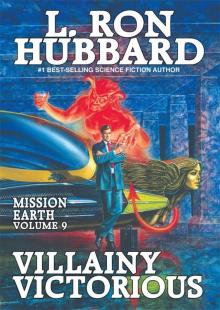 Villainy Victorious
Villainy Victorious Spy Killer
Spy Killer Ai! Pedrito!: When Intelligence Goes Wrong
Ai! Pedrito!: When Intelligence Goes Wrong The Dangerous Dimension
The Dangerous Dimension Mission Earth Volume 1: The Invaders Plan
Mission Earth Volume 1: The Invaders Plan The Slickers
The Slickers If I Were You
If I Were You The Doomed Planet
The Doomed Planet Writers of the Future Volume 31
Writers of the Future Volume 31 Mission Earth Volume 2: Black Genesis
Mission Earth Volume 2: Black Genesis Writers of the Future: 29
Writers of the Future: 29 Death Quest
Death Quest The Enemy Within
The Enemy Within Orders Is Orders
Orders Is Orders Hell's Legionnaire
Hell's Legionnaire L. Ron Hubbard Presents Writers of the Future 34
L. Ron Hubbard Presents Writers of the Future 34 The Scifi & Fantasy Collection
The Scifi & Fantasy Collection Dead Men Kill
Dead Men Kill Ole Doc Methuselah: The Intergalactic Adventures of the Soldier of Light
Ole Doc Methuselah: The Intergalactic Adventures of the Soldier of Light Shadows From Boot Hill
Shadows From Boot Hill Hurricane
Hurricane Mission Earth Volume 3: The Enemy Within
Mission Earth Volume 3: The Enemy Within Slaves of Sleep & the Masters of Sleep
Slaves of Sleep & the Masters of Sleep One Was Stubborn
One Was Stubborn Final Blackout: A Futuristic War Novel
Final Blackout: A Futuristic War Novel Devil's Manhunt
Devil's Manhunt A Matter of Matter
A Matter of Matter Voyage of Vengeance
Voyage of Vengeance If I Were You (Science Fiction & Fantasy Short Stories Collection)
If I Were You (Science Fiction & Fantasy Short Stories Collection) L. Ron Hubbard Presents Writers of the Future Volume 35
L. Ron Hubbard Presents Writers of the Future Volume 35 Mission Earth Volume 4: An Alien Affair
Mission Earth Volume 4: An Alien Affair Black Genesis
Black Genesis Tinhorn's Daughter
Tinhorn's Daughter Trouble on His Wings
Trouble on His Wings Writers of the Future Volume 27: The Best New Science Fiction and Fantasy of the Year
Writers of the Future Volume 27: The Best New Science Fiction and Fantasy of the Year Writers of the Future Volume 28: The Best New Science Fiction and Fantasy of the Year
Writers of the Future Volume 28: The Best New Science Fiction and Fantasy of the Year An Alien Affair
An Alien Affair Cargo of Coffins
Cargo of Coffins Mission Earth Volume 5: Fortune of Fear
Mission Earth Volume 5: Fortune of Fear Writers of the Future 32 Science Fiction & Fantasy Anthology
Writers of the Future 32 Science Fiction & Fantasy Anthology The Baron of Coyote River
The Baron of Coyote River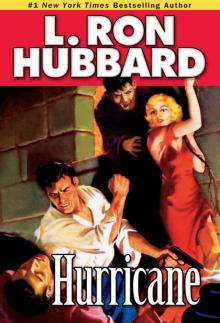 Hurricane (Stories From the Golden Age)
Hurricane (Stories From the Golden Age)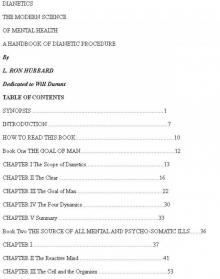 Dianetics: The Modern Science of Mental Health
Dianetics: The Modern Science of Mental Health Writers of the Future, Volume 30
Writers of the Future, Volume 30 Battlefield Earth: A Saga of the Year 3000
Battlefield Earth: A Saga of the Year 3000 Fear
Fear Disaster
Disaster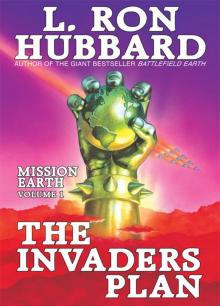 Invaders Plan, The: Mission Earth Volume 1
Invaders Plan, The: Mission Earth Volume 1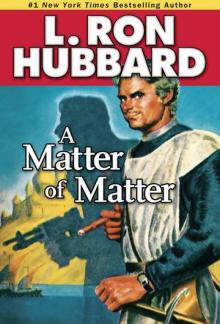 A Matter of Matter (Stories from the Golden Age)
A Matter of Matter (Stories from the Golden Age)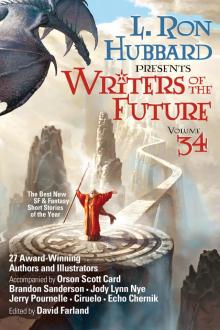 Writers of the Future Volume 34
Writers of the Future Volume 34 Death Waits at Sundown
Death Waits at Sundown One Was Stubbron
One Was Stubbron If I Were You (Stories from the Golden Age)
If I Were You (Stories from the Golden Age) Writers of the Future 32 Science Fiction & Fantasy Anthology (L. Ron Hubbard Presents Writers of the Future)
Writers of the Future 32 Science Fiction & Fantasy Anthology (L. Ron Hubbard Presents Writers of the Future) Writers of the Future, Volume 29
Writers of the Future, Volume 29 Mission Earth Volume 8: Disaster
Mission Earth Volume 8: Disaster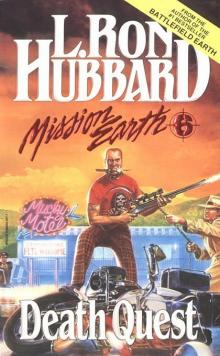 Mission Earth 6: Death Quest
Mission Earth 6: Death Quest Writers of the Future, Volume 27
Writers of the Future, Volume 27 Mission Earth Volume 7: Voyage of Vengeance
Mission Earth Volume 7: Voyage of Vengeance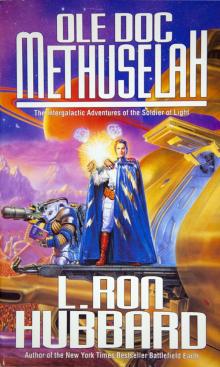 Ole Doc Methuselah
Ole Doc Methuselah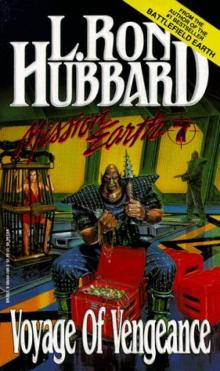 Mission Earth 07: Voyage of Vengeance
Mission Earth 07: Voyage of Vengeance Battlefield Earth
Battlefield Earth Fortune of Fear
Fortune of Fear Mission Earth 8: Disaster
Mission Earth 8: Disaster Mission Earth Volume 10: The Doomed Planet
Mission Earth Volume 10: The Doomed Planet Writers of the Future, Volume 28
Writers of the Future, Volume 28 Mission Earth Volume 6: Death Quest
Mission Earth Volume 6: Death Quest Dead Men Kill (Stories from the Golden Age)
Dead Men Kill (Stories from the Golden Age) Mission Earth 4: An Alien Affair
Mission Earth 4: An Alien Affair Spy Killer (Stories from the Golden Age)
Spy Killer (Stories from the Golden Age) Mission Earth Volume 9: Villainy Victorious
Mission Earth Volume 9: Villainy Victorious L. Ron Hubbard Presents Writers of the Future, Volume 33
L. Ron Hubbard Presents Writers of the Future, Volume 33